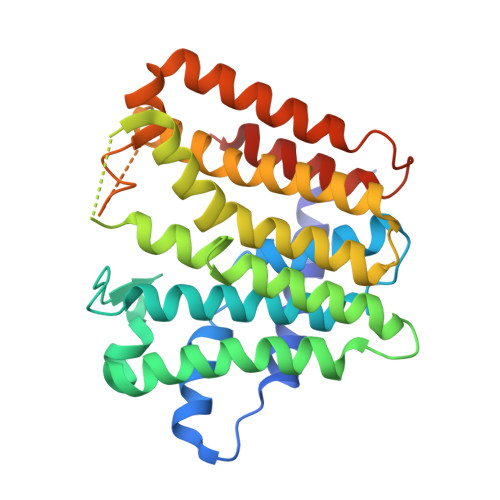Structural Analyses of Short-Chain Prenyltransferases Identify an Evolutionarily Conserved GFPPS Clade in Brassicaceae Plants.
Wang, C., Chen, Q., Fan, D., Li, J., Wang, G., Zhang, P.(2016) Mol Plant 9: 195-204
- PubMed: 26537048
- DOI: https://doi.org/10.1016/j.molp.2015.10.010
- Primary Citation of Related Structures:
5E8H, 5E8K, 5E8L - PubMed Abstract:
Terpenoids are the largest and most diverse class of plant-specialized metabolites, which function in diverse physiological processes during plant development. In the biosynthesis of plant terpenoids, short-chain prenyltransferases (SC-PTs), together with terpene synthases (TPSs), play critical roles in determining terpenoid diversity. SC-PTs biosynthesize prenyl pyrophosphates with different chain lengths, and these compounds are the direct precursors of terpenoids. Arabidopsis thaliana possesses a subgroup of SC-PTs whose functions are not clearly known. In this study, we focus on 10 geranylgeranyl pyrophosphate synthase-like [GGPPSL] proteins, which are commonly thought to produce GGPP [C20]. We found that a subset of members of the Arabidopsis GGPPSL gene family have undergone neo-functionalization: GGPPSL6, 7, 9, and 10 mainly have geranylfarnesyl pyrophosphate synthase activity (C25; renamed AtGFPPS1, 2, 3, and 4), and GGPPSL8 produces even longer chain prenyl pyrophosphate (≥ C30; renamed polyprenyl pyrophosphate synthase 2, AtPPPS2). By solving the crystal structures of AtGFPPS2, AtPPPS2, and AtGGPPS11, we reveal the product chain-length determination mechanism of SC-PTs and interpret it as a "three floors" model. Using this model, we identified a novel GFPPS clade distributed in Brassicaceae plants and found that the GFPPS gene typically occurs in tandem with a gene encoding a TPS, forming a GFPPS-TPS gene cluster.
Organizational Affiliation:
National Key Laboratory of Plant Molecular Genetics, Institute of Plant Physiology and Ecology, Shanghai Institutes for Biological Sciences, Chinese Academy of Sciences, Shanghai 200032, China; University of Chinese Academy of Sciences, Beijing 100039, China.














